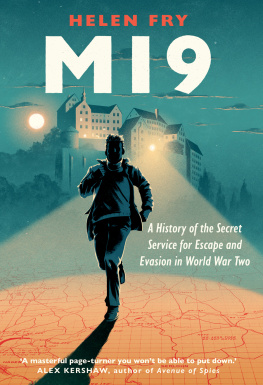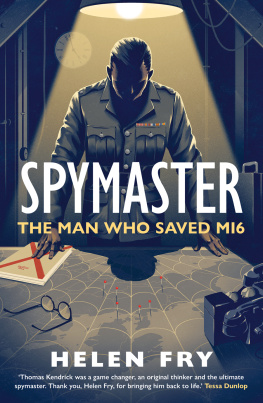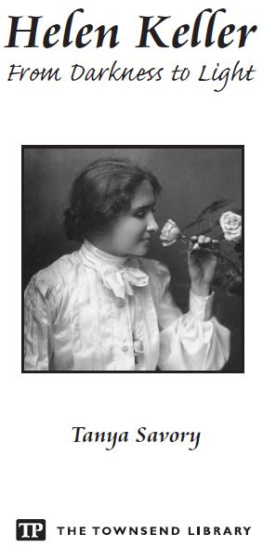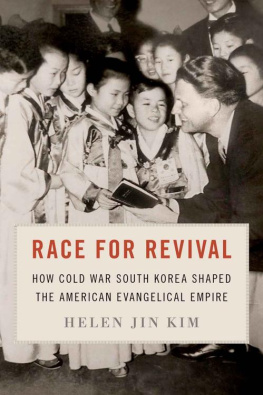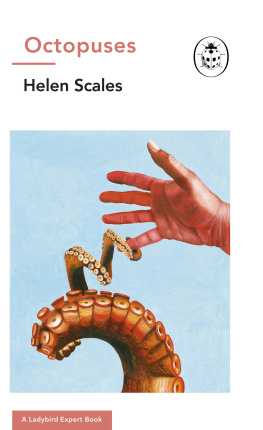Helen Fry - MI9
Here you can read online Helen Fry - MI9 full text of the book (entire story) in english for free. Download pdf and epub, get meaning, cover and reviews about this ebook. publisher: Yale University Press, genre: Politics. Description of the work, (preface) as well as reviews are available. Best literature library LitArk.com created for fans of good reading and offers a wide selection of genres:
Romance novel
Science fiction
Adventure
Detective
Science
History
Home and family
Prose
Art
Politics
Computer
Non-fiction
Religion
Business
Children
Humor
Choose a favorite category and find really read worthwhile books. Enjoy immersion in the world of imagination, feel the emotions of the characters or learn something new for yourself, make an fascinating discovery.
MI9: summary, description and annotation
We offer to read an annotation, description, summary or preface (depends on what the author of the book "MI9" wrote himself). If you haven't found the necessary information about the book — write in the comments, we will try to find it.
MI9 — read online for free the complete book (whole text) full work
Below is the text of the book, divided by pages. System saving the place of the last page read, allows you to conveniently read the book "MI9" online for free, without having to search again every time where you left off. Put a bookmark, and you can go to the page where you finished reading at any time.
Font size:
Interval:
Bookmark:
MI9

Copyright 2020 Helen Fry
All rights reserved. This book may not be reproduced in whole or in part, in any form (beyond that copying permitted by Sections 107 and 108 of the U.S. Copyright Law and except by reviewers for the public press) without written permission from the publishers.
For information about this and other Yale University Press publications, please contact:
U.S. Office:
Europe Office:
Set in Adobe Garamond Pro by IDSUK (DataConnection) Ltd
Printed in Great Britain by TJ International Ltd, Padstow, Cornwall
Library of Congress Control Number: 2020941218
ISBN 978-0-300-23320-9
A catalogue record for this book is available from the British Library.
10 9 8 7 6 5 4 3 2 1
Dedicated to my grandfather
John J. M. Jeffery
DSC, DFC
RNVR, Fleet Air Arm,
spitfire pilot attached to the RAF in the Battle of Britain,
senior test pilot in the Cold War
A WARNING FROM THE PAST
He was in plain clothes, his instinct was to
escape. Here was the risk; as he appeared
on the top of the wall shots might ring out.
He heaved himself up ... his waistcoat hooked
on to something ... he freed it...
he saw a sudden glow in the cupped hands of
a sentry lighting his cigarette ... He dropped
into the garden and crept into some bushes.
To his horror he realised he had left his
food tablets, map and compass on the
wrong side of the wall, as a result of which
he later suffered considerably.
The moral is still the same:
Always Carry Your Escape Aids with You!
This prisoner who escaped in the Boer War became
British Prime Minister Winston Churchill.
(MI9 bulletin, WO 208/3268)
CONTENTS
ILLUSTRATIONS
In text
All chapter head illustrations by Rui Riccardo.
p. : The badge of Intelligence School 9 (Western European) the executive branch of MI9 used in the secret missions over Holland in 1944. Courtesy of Barbara Smith.
p. : Map of major escape lines in Western Europe.
Headers to : Whittington chess set with secret compartments to hide items such as a file and hacksaw.
Headers to : Pencil with a secret miniature compass within, accessed by unscrewing the eraser.
Headers to : Playing cards that, peeled back, reveal an escape map printed inside.
Headers to : Miniature telescope used to observe camp guards when planning escapes, or crossing points on a frontier.
Headers to : 78rpm record concealing an escape map which could be smuggled into POW camps.
Headers to : Walnut shell hiding a miniature compass to aid escape and evasion.
Plates
AUTHORS NOTE
A history of MI9 was first provided by Airey Neave (Saturday at MI9) in 1969. His account, followed by those of Donald Darling and then M.R.D. Foot with Jimmy Langley, closely matches the history and development of MI9 as seen in the official MI9 histories, training lectures and manuals and MI9 bulletins. There are limiting factors with the MI9 files which contain no historical accounts of the formation and history of the Comet Line, Pat Line or sea evacuations. MI9 was running its operations in the context of a war that needed to be won and therefore was clearly not collecting information to write an official history of the escape lines later. The reconstructions by Foot and Langley, Darling and Neave from eyewitness accounts, leaders of the escape lines, helpers and MI9 agents provide the first detailed histories of escape lines that cannot be reconstructed from material in MI9 files.
New material will emerge in this book on the role of MI9s women who worked at its headquarters, first in London and then at Wilton Park in Beaconsfield. MI9 used female interrogators a job traditionally reserved only for men. I also uncover new evidence related to womens intelligence work in occupied Europe. Through simple and ordinary acts of resistance, they made a significant contribution to saving Allied airmen and soldiers. Their stories in Italy are a good example of this. Material is included on the Rome Escape Organisation under Sam Derry and Monsignor OFlaherty a story which, although published in 1960, is often forgotten in books on MI9. It is now
Another area I explore in depth is the contribution of Varian Fry, the American who rescued Jews and intelligentsia from Marseille and smuggled them over the Pyrenees into Spain during 1940-41. Fry, who is no relation to the author, worked in this period for British intelligence as a spy. I look at the undercover work of former Austrian migr Fritz Molden who established networks for British and American intelligence from Italy, into Switzerland and Austria. Included, too, are accounts of the sea evacuations in support of MI9, Special Operations Executive (SOE) and MI6. Access to the family papers of helpers in Britain and Belgium provides more detail to the traditional stories as told by Foot and Langley, and Neave. This is particularly true for the Marchal affair, when the Belgian Marchal family was betrayed, and the personal accounts reveal the subsequent implications of that denouncement for the Comet Line.
If there is a strong theme that emerges in MI9s history, it concerns the commitment and courage of the thousands of helpers, couriers and guides in Europe. They were prepared to work for a secret, unnamed organisation in Britain and were united in the concerted effort to free Europe from Nazi occupation. British Prime Minister Winston Churchill, himself a POW and escaper in the Boer War, understood the difficulties which prisoners had to bear. He sent a rallying message to British POWs to boost their morale:
In this great struggle in which we are engaged, my thoughts are often with you who have had the misfortune to fall into the hands of the Nazi. Your lot is a hard one, but it will help you to keep your courage up to know that all is well at home. Never has the country been so completely united in its determination to exterminate Nazidom and re-establish freedom in the
Churchill was an advocate of unorthodox methods of warfare and wholeheartedly supported the work of MI9. The tales of audacious escapes soon found their way into popular culture and became amongst some of the best-loved stories of the Second World War, inspiring major films such as The Great Escape. But MI9 was as much about the eclectic characters who ran this secret service for escape and evasion as the Allied airmen and soldiers who escaped with the assistance of many known and unknown helpers across Europe.
The challenge in writing this book has been marshalling the sheer volume of research material now available from thousands of declassified MI9 files at the National Archives, to published and unpublished memoirs, biographies, papers in family possession, military archives abroad and primary interviews with former helpers and descendants of MI9 personnel. The quantity of files on MI9 in all theatres of the war would require several published volumes to do it justice, so the main focus of the book is on escape and evasion in Western Europe.
The book is able to provide an updated history of MI9 using declassified files from the National Archives alongside new material released from the Military Archives in Belgium (VSSE), unpublished papers and memoirs, and interviews with families of MI9 and escape line personnel, and a surviving veteran of the Comet Line. By unearthing hitherto unpublished material, I hope to provide an account of the human stories of MI9 alongside the organisation and its operations.
It is important to clarify what kind of material is contained in the MI9 files. These files consist of thousands of escape and evasion reports from the interrogation of returning Allied personnel, as well as historical MI9 bulletins, MI9 and IS9 histories which set out the scope of MI9s work and training, and a small number of files containing citations for the awards to helpers. A limited number of official memos and correspondence is available. This is the extent of the currently declassified MI9 files. The individual files for the helpers have not been released to protect their identity even now, although some names are already known from the citations for their awards, or from their autobiographies. The accounts of MI9 by Foot and Langley, Neave and Darling were written with no apparent access to the then classified files. This is clear from a comment by Foot and Langley that whether escapers and evaders provided a significant body of intelligence remains an official secret. It is my intention over the course of the following pages to answer this question and show how MI9s escapers and evaders did make an important contribution to intelligence.
Next pageFont size:
Interval:
Bookmark:
Similar books «MI9»
Look at similar books to MI9. We have selected literature similar in name and meaning in the hope of providing readers with more options to find new, interesting, not yet read works.
Discussion, reviews of the book MI9 and just readers' own opinions. Leave your comments, write what you think about the work, its meaning or the main characters. Specify what exactly you liked and what you didn't like, and why you think so.

